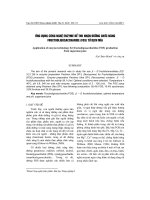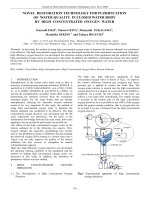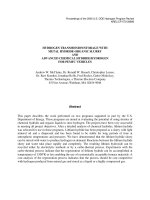Battery Technology for Electric Vehicles
Bạn đang xem bản rút gọn của tài liệu. Xem và tải ngay bản đầy đủ của tài liệu tại đây (5.57 MB, 147 trang )
Battery Technology for
Electric Vehicles
Electric drive vehicles (EDVs) are seen on American roads in increasing numbers. Related to this market trend and critical for it to increase are improvements
in battery technology. Battery Technology for Electric Vehicles examines in detail
the research support from the U.S. Department of Energy (DOE) for the development of nickel metal hydride (NiMH) and lithium-ion (Li-ion) batteries used in
EDVs. With public support comes accountability of the social outcomes associated with public investments.
The book overviews DOE investments in advanced battery technology, documents the adoption of these batteries in EDVs on the road, and calculates the
economic benefits associated with these improved technologies. It provides a
detailed global evaluation of the net social benefits associated with DOE investments, the results of the benefit-to-cost ratio of over 3.6-to-1, and the life-cycle
approach that allows adopted EDVs to remain on the road over their expected
future life, thus generating economic and environmental health benefits into the
future.
Albert N. Link is Professor of Economics at the University of North Carolina at
Greensboro, USA. His research is related to the economics of innovation, technology policy, and program evaluation.
Alan C. O’Connor is an economist and Director of Innovation Economics at
RTI International. He specializes in economic analysis of research and development (R&D) programs, program evaluation, and economic development.
Troy J. Scott is an economist at RTI International, where his research deals with
the economics of technology and innovation. His work focuses on the nexus
of public support for research and development (R&D), regulation, and R&D
rivalry among firms to evaluate and inform public policy.
“Fifty years ago Edwin Mansfield used economics and econometrics with in-depth
case studies to transform our understanding of innovation. Since 1972, federal
agencies have invested over a billion dollars in the battery technologies important to electric vehicles. Link, O’Connor, and Scott use the ‘Mansfield’ strategy
to take readers ‘under the hood’ and ask if these programs were in the public
interest. Their book is a great read!”
V. Kerry Smith, Arizona State
University, USA
“The authors address an important issue which is high on the policy agenda in
many industrialized countries. Even using conservative estimates about social
benefits of public support for new technologies, they find substantial ones. In
the vein of discussing public/private partnerships in science and technology, this
study is a must-read for policy makers and research funders in the field.”
Wolfgang Polt, Institute for Economic and
Innovation Research, Austria
“This tome presents a thorough empirical economic evaluation of the social benefits attributable to federal R&D investment in vehicle battery technology in the
United States. Link, O’Connor, and Scott have produced one of the best such
appraisals available. A must-read.”
Nicholas S. Vonortas, George Washington
University, USA
Battery Technology for
Electric Vehicles
Public science and private innovation
Albert N. Link, Alan C. O’Connor,
and Troy J. Scott
First published 2015
by Routledge
2 Park Square, Milton Park, Abingdon, Oxon OX14 4RN
and by Routledge
711 Third Avenue, New York, NY 10017
Routledge is an imprint of the Taylor & Francis Group, an informa business
© 2015 Albert N. Link, Alan C. O’Connor, and Troy J. Scott
The right of Albert N. Link, Alan C. O’Connor, and Troy J. Scott to be
identified as authors of this work has been asserted by them in accordance
with sections 77 and 78 of the Copyright, Designs and Patents Act 1988.
All rights reserved. No part of this book may be reprinted or reproduced
or utilised in any form or by any electronic, mechanical, or other means,
now known or hereafter invented, including photocopying and recording,
or in any information storage or retrieval system, without permission in
writing from the publishers.
Trademark notice: Product or corporate names may be trademarks or
registered trademarks, and are used only for identification and explanation
without intent to infringe.
British Library Cataloguing-in-Publication Data
A catalogue record for this book is available from the British Library
Library of Congress Cataloging-in-Publication Data
Link, Albert N.
Battery technology for electric vehicles : public science and private
innovation / Albert N. Link, Alan C. O’Connor, and Troy J. Scott.
pages cm
Includes bibliographical references and index.
1. Electric vehicles – Batteries. 2. Electric vehicles – Cost effectiveness.
I. O’Connor, Alan C. II. Scott, Troy J. III. Title.
TL220.L56 2015
629.25 – dc23
2014039612
ISBN: 978–1–138–81110–2 (hbk)
ISBN: 978–1–315–74930–3 (ebk)
Typeset in Goudy
by Swales & Willis Ltd, Exeter, Devon, UK
For Carol, Scott, and Dorothy
This page intentionally left blank
Contents
List of figures
List of tables
Acknowledgements
List of abbreviations
1 Introduction
viii
x
xii
xiii
1
2 Public/private research partnerships
18
3 The adoption of battery technology in EDVs
30
4 Measurement of economic and energy benefits
47
5 Measurement of environmental health and energy
security benefits
79
6 Comparison of benefits and costs of VTO’s R&D investments
101
7 Conclusions
111
References
Index
123
128
Figures
1.1
2.1
2.2
2.3
2.4
3.1
3.2
4.1
4.2
4.3
4.4
4.5
4.6
A4.1
A4.2a
A4.2b
A4.3
A4.4
5.1
5.2
Cumulative VTO R&D investments in energy storage
technologies, 1976 through 2012
Decision-making model for public R&D investments
Cumulative USABC R&D investments in energy storage
technologies, 1992 through 2010
VTO’s R&D investments for NiMH and Li-ion battery
technologies, by company, 1995 through 2010 (millions $)
Innovative paradigm for a public/private technology partnership
Electric drive vehicles in the United States, by battery
technology and by type, 1999 through 2012
EDV market share, 1999 through 2012
Value chain of Li-ion batteries for vehicles
Counterfactual battery life (charging cycles) improvement
without VTO support
Counterfactual energy density (Wh/kg) improvement without
VTO support
Counterfactual cost ($/kWh) improvement without VTO
support
Market adoption of EDVs in the United States since 1999;
percentage of cars sold in the United States powered by
NiMH or Li-ion battery technology
95 percent confidence interval on percentage of market adoption
of EDVs attributable to VTO’s R&D investments (actual
adoption curve comes from Figure 4.5)
Charging cycles and calendar life (assuming full discharge)
Energy density in NiMH batteries (Wh/kg)
Energy density in Li-ion batteries (Wh/kg)
Cost in NiMH (top) and Li-ion (bottom) batteries ($/kWh)
Battery technology adoption
Well-to-wheels, well-to-pump, and pump-to-wheels analysis for
fuel and vehicle systems
Approach for assessing environmental health benefits and
energy security benefits from EDVs
6
20
23
25
27
31
32
53
55
55
56
58
60
73
73
74
74
75
80
82
Figures ix
5.3
A5.1
A5.2
Cumulative pump-to-wheel-avoided greenhouse gas
emissions (thousands of metric tons of CO2eq)
WtW-avoided GHG emissions (thousands of metric tons of
CO2eq)
COBRA model overview
84
93
96
Tables
1.1
VTO’s R&D investments in battery technologies, 1976
through 2012
2.1
Taxonomy of public/private partnership mechanisms and
structures
2.2
Performance metrics established by USABC
2.3
DOE’s role in the public/private partnership to support
battery technology
3.1
NiMH HEV car sales, by model and year, 1999 through 2012
3.2
NiMH HEV sport-utility and light-duty truck sales, by model
and year, 2004 through 2012
3.3
Li-ion HEV sales, by model and year, 2010 through 2012
3.4
PHV/EV (Li-ion) sales, by model and year, 2011 through 2012
A3.1 Technical performance of common cell chemistries used in
EDV battery pack systems, circa 2010
A3.2 Selected differences between Li-ion and NiMH battery
technology
A3.3 Illustrative snapshot of Li-ion chemistries with automotive
applications, circa 2008
4.1
Participants in the data collection process, by stakeholder
category
4.2
Distribution of company participants by battery technology
area, n=25
4.3
Distribution of evaluation participants along the Li-ion
battery value chain
4.4
Battery life, energy density, cost, and Li-ion EDV sales
improvement attributable to VTO R&D investments
4.5
Percentage of market adoptions of EDVs attributable to
VTO R&D investments in NiMH and Li-ion battery
technologies, n=44
4.6
Market adoption of HEV, PHEV, and EVs in the United States
attributable to VTO’s R&D investments
4.7
Average miles driven by vehicle age
4.8
Attributable HEVs on the road, by year and vehicle age
7
21
26
27
33
35
36
36
39
41
44
52
52
54
54
57
61
62
63
Tables
4.9
4.10
4.11
4.12
4.13
A4.1
5.1
5.2
5.3
5.4
5.5
5.6
5.7
5.8
5.9
5.10
A5.1
A5.2
A5.3
A5.4
A5.5
A5.6
6.1
6.2
6.3
6.4
6.5
7.1
Attributable PHEVs on the road, by year and vehicle age
Attributable EVs on the road, by year and vehicle age
Attributable fuel savings for U.S. HEVs, PHEVs, and EVs,
1999 through 2022
Gallons of gasoline saved per 1,000 attributable miles driven
Inflation-adjusted price of gasoline per gallon, by year
Participating organizations
List of air pollutants
Pump-to-wheels greenhouse gas emissions factors
Attributable miles driven by vehicle type, 1999 through 2022
Pump-to-wheel avoided greenhouse gas emissions, by vehicle
type
Pump-to-wheels air quality criteria pollutant emissions factors
Pump-to-wheel avoided air quality criteria pollutant
emissions from EDVs, 1999 through 2022
Pump-to-wheels avoided air quality criteria pollutant emissions,
by vehicle type
Pump-to-wheels environmental health benefits associated with
using EDVs, 2017
Pump-to-wheels time series of environmental health benefits
associated with using EDVs, 1999 through 2022
Pump-to-wheels energy security benefits, 1999 through 2022
WtW GHG emissions factors (g/mile)
WtW-avoided GHG emissions by vehicle type (thousands of
metric tons of CO2eq)
WtW air quality criteria pollutant emissions factors (mg/mile)
WtW-avoided air quality criteria pollutant emissions from
EDVs (short tons), 1999 through 2022
WtW-avoided air quality criteria pollutant emissions, by
vehicle type (short tons)
Health endpoints included in COBRA
VTO R&D investments in energy storage technology, 1992
through 2012
Attributable economic and energy benefits, 1999 through 2022
Attributable mean environmental health benefits, 1999
through 2022
Attributable total economic and energy and environmental
health benefits, 1999–2022
Evaluation metrics: economic and environmental health
benefits, retrospective evaluation 1999 through 2012
Summary benefit–cost analysis results
xi
64
64
66
67
67
77
81
83
83
84
86
87
88
89
91
92
93
94
94
95
96
97
102
104
105
106
108
113
Acknowledgements
A number of individuals contributed to this study, both in terms of their participation during the data collection effort and in terms of their comments and
suggestions on earlier versions of these chapters.
We are grateful to the scientists, engineers, and analysts that contributed
data and insight that informed the evaluation portion of this study, including
those from A123 Systems (Navitas Systems), Amprius, Applied Materials, BASF
Materials USA, BASF Catalysts, Dow Kokam, EnerDel, FMC Corporation, Ford
Motor Company, General Motors, H&T Waterbury, K2 Energy Solutions, LG
Chem Power, Maxwell Technologies, Miltec UV International, Nanosys, Saft
America, Seeo, Ultimate Membrane Technologies, Northwestern University,
Pennsylvania State University, SUNY Binghamton, University of Massachusetts
Boston, University of Pittsburgh, University of Rhode Island, Argonne National
Laboratory, Brookhaven National Laboratory, Idaho National Laboratory,
Lawrence Berkeley National Laboratory (LBNL), National Renewable
Energy Laboratory, Oak Ridge National Laboratory, Pacific Northwest National
Laboratory, Southwest Research Institute, and U.S. Army Research Laboratory.
We are also grateful to a number of individuals who offered valuable comments
and suggestions (alphabetically): Tien Duong (Vehicle Technologies Office
[VTO] in the Office of Energy Efficiency and Renewable Energy [EERE] within
the Department of Energy [DOE]), Irwin Feller (consultant to the American
Association for the Advancement of Science), David Finifter (The College of
William & Mary), Michael Gallaher (RTI International), Ken Keating (consultant to EERE), David Howell (VTO), William Key (VTO), Cheryl Oros
(Oros Consulting), Rosalie Ruegg (TIA Consulting), Edward Vine (LBNL), and
Thomas White (DOE Office of Policy).
A special thanks to Yaw Agyeman (LBNL) and Jeff Dowd (EERE) who supported financial assistance to conduct this study. And, a special thanks to the
Center on Globalization, Governance and Competitiveness at Duke University
for the use of Figure 4.1.
Lastly, we are indebted to Sara Casey, Ross Loomis, and Lynn Davis, all of RTI
International, for their invaluable contributions to this project.
Abbreviations
ACE
AEC
ARRA
a-Si
BCR
BEA
CAFE
CARB
CDC
CdTe
CFC
CIS
CO2eq
COBRA
CRADA
CRF
c-Si
DOD
DOE
ECD
EDV
EERE
EPA
EPAct
EPRI
ERDA
EV
FSA
GHG
GM
GTP
GWP
advanced combustion engine
Atomic Energy Commission
American Recovery and Reinvestment Act
amorphous silicon
benefit-to-cost ratio
Bureau of Economic Analysis
Corporate Average Fuel Economy
California Air Resources Board
Centers for Disease Control and Prevention
cadmium telluride
chlorofluorocarbon
copper indium diselenide
equivalent CO2
Co-Benefits Risk Assessment
Cooperative Research and Development Agreement
Combustion Research Facility
crystalline silicon
depth of discharge
Department of Energy
Energy Conversion Devices
electric drive vehicle
Office of Energy Efficiency and Renewable Energy
Environmental Protection Agency
Energy Policy Act of 1992
Electric Power Research Institute
Energy Research and Development Administration
electric vehicle
Flat-Plate Solar Array Project
greenhouse gas
General Motors
Geothermal Technologies Program
global warming potential
xiv Abbreviations
HEV
ICV
IDMS
IRR
JCS
JPL
LAS
LDV
LIF
LII
Li-ion
LRS
MATS
mpg
MRAD
MW
NiMH
NIST
NOx
NPV
NRC
NREL
OEM
OMB
OPEC
OTA
OTP
OTT
PDC
PHEV
PIV
PM
PNGV
PtW
PV
PVMaT
R&D
SCC
SRM
SETP
TCP
TFPs
TOUGH
USABC
USCAR
hybrid electric vehicle
internal-combustion vehicle
Isotope Dilution Mass Spectrometry
internal rate of return
Johnson Controls/Saft
Jet Propulsion Laboratory
laser absorption spectrometry
Laser Doppler velocimetry
laser-induced fluorescence
laser-induced incandescence
Lithium-ion
laser Raman spectroscopy
Mercury and Air Toxics Standards
miles per gallon
minor restricted activity days
megawatt
nickel metal hydride
National Institute of Standards and Technology
nitrogen oxides
net present value
National Research Council
National Renewable Energy Laboratory
original equipment manufacturers
Office of Management and Budget
Organization of the Petroleum Exporting Countries
Office of Technology Assessment
Office of Technology Policy
Office of Transportation Technologies
polycrystalline diamond compact
plug-in hybrid electric vehicles
particle image velocimetry
particulate matter
Partnership for a New Generation of Vehicles
pump-to-wheel
photovoltaic
PV Manufacturing Technology Project
research and development
Social Cost of Carbon
Standard Reference Material
Solar Energy Technology Program
Thermocouple Calibration Program
Thin-Film PV Partnerships
Transport of Unsaturated Groundwater and Heat
U.S. Advanced Battery Consortium
U.S. Council for Automotive Research
Abbreviations xv
VOCs
VTO
VTP
WtP
WtW
volatile organic compounds
Vehicle Technologies Office
Vehicle Technologies Program
well-to-pump
well-to-wheel
This page intentionally left blank
1
Introduction
The policy imperative
At the time of the Organization of the Petroleum Exporting Countries (OPEC)
oil embargo, the only U.S. government agency related to energy was the Atomic
Energy Commission (AEC).1,2 In response to the OPEC oil embargo, President
Nixon launched Project Independence on November 7, 1973; the goal of the
project was to achieve energy independence by 1980. In his State of the Union
Address on January 30, 1974, President Nixon remarked (Nixon, 1974):
Let it be our national goal: At the end of this decade, in the year 1980, the
United States will not be dependent on any other country for the energy we
need to provide our jobs, to heat our homes, and to keep our transportation
moving.
Others at that time also editorialized about the importance of the oil embargo on
the future direction of U.S. energy policy (Dooley 2008, p. 9):
The [OPEC] Oil Embargo which began on October 19, 1973 sparked a fundamental reassessment of the nation’s vulnerability to imported energy and
also forced a reassessment of the role that energy R&D could play in helping
secure the nation against hostile acts like the Oil Embargo.
The United States’ heightened interest in alternative energy sources led in
1975 to replacement of the AEC by the Energy Research and Development
Administration (ERDA) in an effort to unify the federal government’s energy
R&D activities. Congress charged ERDA to sponsor research and development
(R&D) related to electric and hybrid vehicles through the passage of the Electric
and Hybrid Vehicle Research, Development, and Demonstration Act of 1976,
Public Law 94-413. Therein:3
The Congress finds and declares that:
1
the Nation’s dependence on foreign sources of petroleum must be
reduced, as such dependence jeopardizes national security, inhibits foreign policy, and undermines economic well-being;
2
Introduction
2
3
4
the Nation’s balance of payments is threatened by the need to import oil
for the production of liquid fuel for gasoline-powered vehicles;
the single largest use of petroleum supplies is in the field of transportation, for gasoline- and diesel-powered motor vehicles;
the expeditious introduction of electric and hybrid vehicles into the
Nation’s transportation fleet would substantially reduce such use and
dependence.
On August 4, 1977, President Carter signed the Department of Energy
Reorganization Act of 1977, Public Law 95-91, transferring the mission of
ERDA to the newly formed Department of Energy (DOE). As stated in the Act,
Congress finds that:
•
•
•
•
•
the United States faces an increasing shortage of nonrenewable energy
resources;
this energy shortage and our increasing dependence on foreign energy
supplies present a serious threat to the national security of the United
States and to the health, safety and welfare of its citizens;
a strong national energy program is needed to meet the present and
future energy needs of the Nation consistent with overall national economic, environmental and social goals;
responsibility for energy policy, regulation, and research, development
and demonstration is fragmented in many departments and agencies and
thus does not allow for the comprehensive, centralized focus necessary
for effective coordination of energy supply and conservation programs;
and
formulation and implementation of a national energy program require
the integration of major Federal energy functions into a single department in the executive branch.
By this act, Congress declared that the establishment of a Department of Energy
in the Executive Branch is in the public interest and will promote the general
welfare by assuring coordinated and effective administration of Federal energy
policies and programs. DOE will:
carry out the planning, coordination, support, and management of a balanced and comprehensive energy research and development program,
including – (A) assessing the requirements for energy research and development; (B) developing priorities necessary to meet those requirements;
(C) undertaking programs for the optimal development of the various forms
of energy production and conservation; and (D) disseminating information
resulting from such programs.
Motivated by the Electric and Hybrid Vehicle Research, Development, and
Demonstration Act of 1976, and the subsequent availability of public funding,
Introduction 3
Chrysler (now Chrysler Group LLC), Ford Motor Company, and General Motors
(GM) established in early 1991 the U.S. Advanced Battery Consortium
(USABC) to accelerate the development of batteries for electric drive vehicles
(EDVs). The term ‘EDV’ refers to all types of electric drive vehicles including:4
•
•
•
hybrid electric vehicles (HEVs), which use gasoline to charge the battery
and part of the time to power the vehicle (e.g., the first-generation Prius);
electric vehicles (EVs), which are powered exclusively by a battery and must
be plugged into an electrical outlet to recharge (e.g., the Tesla Model S,
Nissan Leaf); and
plug-in hybrid electric vehicles (PHEV), which can either use gasoline to
recharge the battery and power the vehicle or be plugged in to recharge the
battery (e.g., the Chevrolet Volt).
The creation of the USABC was also motivated, in part, by the recent California
Air Resources Board’s (CARB’s) 1990 regulations for low-emission vehicles and
its clean fuel standards for emissions that were to be applied to new classes of
vehicles not later than 1994. USABC’s purpose was to:
work with advanced battery developers and companies that will conduct research and development (R&D) on advanced batteries to provide
increased range and improved performance for electric vehicles in the latter
part of the 1990s.
(National Research Council (NRC) 1998, p. 12)
More specifically, the USABC had the following overarching objectives:
•
•
•
•
to establish a capability for an advanced battery manufacturing industry
in the United States;
to accelerate the market potential of EVs through joint research on the
most promising advanced battery alternatives;
to develop electrical energy systems capable of providing EVs with ranges
and performance levels competitive with petroleum-based vehicles;
to leverage external funding for high-risk, high-cost R&D on advanced
batteries for EVs.
(NRC 1998, p. 21)
DOE joined the consortium in late 1991 in response to its mandate through the
Electric and Hybrid Vehicle Research, Development, and Demonstration Act of
1976. And, this mandate was reconfirmed through the Energy Policy Act of 1992
(EPAct).5 In addition, the Electric Power Research Institute (EPRI) joined the
consortium in 1991.6
Related to the ongoing charge for DOE’s involvement in electric and
hybrid vehicles and related battery research, President Clinton initiated the
Partnership for a New Generation of Vehicles (PNGV) program in 1993.
4 Introduction
This was a cooperative R&D program between the federal government and the
U.S. Council for Automotive Research (USCAR), which included Chrysler,
Ford, GM, and relevant federal agencies and the national laboratories (Sissine
1996).7 Noteworthy was one of the original technology goals of PNGV (Sissine
1996, p.1):
Research and development goals for industry and government engineering
teams have been launched in three categories: advanced manufacturing
techniques that help get new product ideas more quickly into the marketplace; technologies that can lead to near-term improvements in automobile
efficiency, safety, and emissions; and research that could lead to production
prototypes of vehicles capable of up to 80 miles per gallon – three times
greater fuel efficiency than the average car of today.
More specifically, the goals of the PNGV were (NRC 2001, p. 146):
(1) to improve national manufacturing competitiveness, (2) to implement
commercially viable technologies that increase the fuel efficiency and reduce
the emissions from conventional vehicles, and (3) to develop technologies
for a new class of vehicles with up to three times the fuel efficiency of 1994
midsize family sedans (80 mpg) while meeting emission standards and without sacrificing performance, affordability, utility, safety, or comfort.
A more fuel-efficient car might achieve the stated goal of 80 miles per gallon
(mpg). But, a 1995 Office of Technology Assessment (OTA) report stated that
there was at that time (i.e., 1993) no battery technology capable of achieving the
equivalent of 80 mpg. However, the report went on to state that: “Nickel metalhydride batteries are seen as the only longer-term battery technology that could
possibly be designed to reach the 80 mpg target” (OTA 1995, p. 17).8
Overview of EERE R&D support for battery technology
Within DOE, the Office of Energy Efficiency and Renewable Energy (EERE)
“accelerates development and facilitates deployment of energy efficiency and
renewable energy technologies and market-based solutions that strengthen U.S.
energy security, environmental quality, and economic vitality.”9 EERE leads
DOE’s “efforts to develop and deliver market-driven solutions for energy-saving
homes, buildings, and manufacturing; sustainable transportation; and renewable
electricity generation.”10
EERE consists of several offices and programs that support its mission.11 Related
to energy efficiency are the Advanced Manufacturing Office, the Buildings
Technology Office, the Federal Energy Management Program, the Weatherization
and Intergovernmental Program, and the Sustainability Performance Office.
Related to renewable power are the Geothermal Technologies Office, the
Solar Energy Technologies Office, the Wind Program, and the Water Power
Introduction 5
Program. And regarding transportation are the Bioenergy Technologies Office,
the Hydrogen and Fuel Cell Technologies Office, and the Vehicle Technologies
Office (VTO).
The mission of VTO – the R&D program that is the focus in this book – is:12
to develop more energy efficient and environmentally friendly highway
transportation technologies that enable America to use less petroleum.
The long-term aim is to develop “leap frog” technologies that will provide
Americans with greater freedom of mobility and energy security, with lower
costs and lower impacts on the environment.
Energy storage technology development is an essential element of VTO’s
mission:13
•
•
•
Energy storage technologies, especially batteries, are critical enabling
technologies for developing advanced, fuel-efficient, light- and heavyduty vehicles, which are key components of DOE’s Energy Strategic
Goal: “to protect our national and economic security by promoting a
diverse supply and delivery of reliable, affordable, and environmentally
sound energy.”
VTO “supports the development of durable and affordable advanced
batteries that cover the full range of vehicle applications, from start/stop
to full-power hybrid electric, electric, and fuel cell vehicles.”14
Energy storage research aims to overcome specific technical barriers that
have been identified by the automotive industry together with VTO –
cost, performance, life, and abuse tolerance. These barriers are being
addressed collaboratively by DOE’s technical research teams and battery
manufacturers.
DOE has invested in energy storage technologies since 1976. Figure 1.1 shows
VTO’s R&D investments in energy storage technologies from 1976 through
2012 in nominal and in real 2012 dollars (2012$). The R&D data that underlie
Figure 1.1 are in Table 1.1.
VTO’s funding toward advanced battery research in nickel metal hydride
(NiMH) and lithium-ion (Li-ion) battery technology, in particular, began in
1992. More specifically, VTO’s R&D investments in energy storage technology
totaled $1,168 million in 2012 dollars from 1976 through 2012 (see Figure 1.1).
The $197 million invested prior to 1992 supported general energy storage technologies such as batteries other than NiMH and Li-ion, flywheels, and ultracapacitors; as well as testing methods and standards development. The $971 million
invested from 1992 through 2012 included primarily VTO’s support for NiMH
and Li-ion battery technologies.
The remainder of this book presents the results of an economic evaluation
of the net social benefits attributable to VTOs R&D investments in battery
technologies – NiMH and Li-ion battery technologies in particular. The premise
6
Introduction
1,200
Dollars (millions)
1,000
800
600
400
200
1976
1977
1978
1979
1980
1981
1982
1983
1984
1985
1986
1987
1988
1989
1990
1991
1992
1993
1994
1995
1996
1997
1998
1999
2000
2001
2002
2003
2004
2005
2006
2007
2008
2009
2010
2011
2012
-
Years
Nominal Dollars
Real 2012 Dollars
Figure 1.1 Cumulative VTO R&D investments in energy storage technologies, 1976
through 2012
Sources: Investment data provided by DOE. GDP chain-type price index from U.S. Department of
Commerce, Bureau of Economic Analysis, downloaded from the St. Louis Federal Reserve, http://
research.stlouisfed.org/fred2/series/GDPCTPI/downloaddata?cid=21.
Note: The data underlying Figure 1.1 are presented in Table 1.1.
of the evaluation is that these investments accelerated the development of battery
technology relative to the timeline of development that would have unfolded in
a counterfactual scenario without VTO investments. Central to this premise is
the notion that public R&D investments may have positive social net present
value although the same investments would not have been undertaken by the
private sector alone. The economic arguments for why private underinvestment
in R&D may be expected and how public-sector involvement may then improve
efficiency are discussed in Chapter 2. The extent to which public investments
did in fact accelerate technological development was ascertained through interviews with 54 experts in vehicle energy storage technologies, representing VTOfunded battery companies, car companies, research laboratories, and universities.
With respect to NiMH technology, one interviewee noted that “without DOE,
there would be essentially no U.S. [energy storage] industry. Technology would
still have been developed abroad in, for example, Japan and Korea, and EDVs
would still have made their way into the U.S. market, but it would have taken
Table 1.1 VTO’s R&D investments in battery technologies, 1976 through 2012
Fiscal
year
(1)
Nominal appropriations
(thousands of current $s)
(2)
Price index
(2005 = 100)
(3)
Price index
(2012 = 100)
(4)
Appropriations
(thousands of 2012$s)
1976
1977
1978
1979
1980
1981
1982
1983
1984
1985
1986
1987
1988
1989
1990
1991
1992
1993
1994
1995
1996
1997
1998
1999
2000
2001
2002
2003
2004
2005
2006
2007
2008
2009
2010
2011
2012
5,300
5,300
5,500
5,200
7,700
7,100
5,300
5,500
4,400
4,280
3,622
5,220
5,174
6,417
7,870
8,836
26,412
30,911
35,816
27,724
26,770
25,497
27,738
22,784
23,433
27,706
26,667
24,517
22,637
25,855
28,134
44,412
49,048
73,425
78,921
83,299
93,034
35.5
37.8
40.4
43.8
47.8
52.3
55.5
57.7
59.9
61.7
63.1
64.8
67.0
69.6
72.3
74.8
76.6
78.3
79.9
81.6
83.2
84.6
85.6
86.8
88.7
90.7
92.2
94.1
96.8
100.0
103.2
106.2
108.6
109.5
111.0
113.4
115.4
30.8
32.8
35.1
38.0
41.4
45.4
48.1
50.0
51.9
53.5
54.7
56.2
58.1
60.3
62.6
64.9
66.4
67.9
69.3
70.7
72.1
73.3
74.2
75.3
76.9
78.6
79.9
81.6
83.9
86.7
89.5
92.1
94.1
94.9
96.2
98.3
100.0
17,209
16,180
15,690
13,695
18,580
15,656
11,015
10,997
8,479
8,006
6,628
9,292
8,904
10,641
12,564
13,625
39,783
45,557
51,699
39,200
37,145
34,763
37,397
30,272
30,474
35,234
33,375
30,051
26,987
29,832
31,444
48,238
52,128
77,347
82,035
84,778
93,034
Sources: Appropriations data provided by DOE. GDP chain-type price index from U.S. Department
of Commerce, Bureau of Economic Analysis, downloaded from the St. Louis Federal Reserve, http://
research.stlouisfed.org/fred2/series/GDPCTPI/downloaddata?cid=21.
Note: Nominal appropriations include battery storage R&D and Small Business Innovation Research
(SBIR) funded R&D. FY 1998 funding is an estimate of Phase I awards made in years prior to 1999.
The estimate is based on Phase II awards between 1999 and 2003 for which no Phase 1 awards are
tabulated. SBIR funding is the total funds awarded in a given year for automotive-related energy
storage projects. The awards are made as a result of the solicitation and selection process managed by
the Office of Science within the U.S. Department of Energy.
8
Introduction
longer.” Another interviewee noted that VTO’s impact on Li-ion technology was
still greater: “It is possible that without the [VTO’s] support for battery technology development, there might presently be no Li-ion technology in the EDV
market.” These comments are representative of the connection, drawn by interviewees, between advancements in the state-of-the-art battery technology and
the diffusion of that technology through the market adoption of EDVs: Only
as the range and performance of EDVs improved and as costs were lowered did
EDVs become a viable alternative to conventional internal-combustion vehicles
(ICVs). The benefits quantified in this evaluation – and used to determine the
social rate of return on VTO’s investments – stem from the accelerated diffusion
of EDVs that can be attributed to VTO. Specifically, each EDV on the U.S. market is assumed to have displaced an ICV, with a corresponding reduction in the
consumption of fossil fuel; for a fraction of those EDVs (its estimated size based
on the perceptions and opinions of interviewees) the benefits associated with this
reduced fossil fuel consumption are attributed to VTO. The remaining sections of
this chapter describe the evaluation approach in greater detail.
An overview of the evaluation approach
The evaluation herein builds on the pioneering work of Griliches (1958) and
Mansfield et al. (1977) to develop estimates of the social rate of return to VTO’s
investments in battery R&D.15 The Griliches/Mansfield methodology holds fixed,
in the counterfactual situation, the status-quo technology that prevailed prior to
the new technology brought forth with support from public R&D investments.
Our approach is a modified version of this one. We recognize that the status-quo
technology would not have remained fixed in the absence of VTO investments.
Rather, the counterfactual situation involves battery technology being developed and adopted (through the sale of EDVs) at a different rate. We estimated
counterfactual rates of development and adoption based on our interviews and
derived the stream of estimated benefits from the comparison of this counterfactual description with the actual observed time series of EDV adoption. Streams of
VTO investment outlays (the costs) are compared with estimates of the streams
of economic surplus those investments have generated (the benefits), by means
of conventional evaluation metrics: net present values, benefit-to-cost ratios, and
internal rates of return.16
Social benefits beginning in 1999 and continuing through 2022 are quantified, and they are compared with VTO’s R&D investments from 1992 through
2012.17 The timeline of the stream of benefits begins in 1999 with the first EDVs
on the road in the United States. EDVs are assumed to be driven for 11 years
(with details of annual mileage assumptions provided in Chapter 4); the stream
of benefits therefore ends in 2022, the last year in which EDVs purchased in 2012
are driven. A conservative, lower-bound estimate of benefits is also considered,
truncating the stream of benefits at 2012.
Three categories of social benefits are considered: economic and energy benefits, environmental health benefits, and energy security benefits.18 The principal









